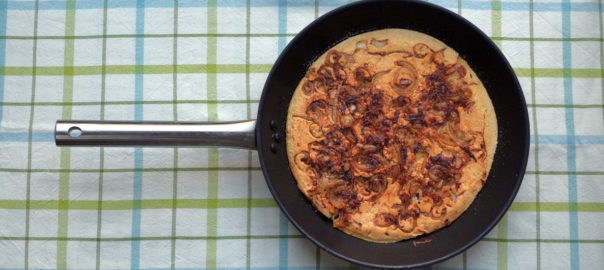Yoga Kitchen – Simple, healthy and vegan
Twenty-one grams of protein. That’s what one portion of this Italian-inspired vegetable omelette represents. Super easy to make and oh so tasty.
And there is not one egg involved. Why I don’t use eggs anymore you can read at the bottom of this article. By the way, it is so easy to either omit eggs or to substitute them in a natural and very qualitative way in culinary preparations.
For a rich omelette for two people:
For the filling:
- 3 red (or yellow) onions
- equally 3 shallots
- and 3 large cloves of garlic
- 2 tablespoons of olive oil
- ¼ teaspoon of nutmeg
- Some black pepper and sea or himalayan pink salt
- 1 tablespoon balsamic vinegar
For the vegan “egg batter”:
- 140 gram chickpea flour
- approximately 350 ml water
- 3 tablespoons nutritional yeast flakes
- 1 teaspoon of sea salt or himalayan pink salt
A large frying pan, preferably with a non-stick coating, and a lid that fits.
How to proceed:
Preparing the filling
- Place the 4 ingredients for the batter in a large bowl and batter with a garden.
Make sure that the mixture has the consistency of pancake batter. - Heat the olive oil in the frying pan.
- Fry the onions, shallots, garlic and nutmeg in the olive oil until they turn glassy and light brown. In culinary terms, this is called “caramelisation”.
- Stir regularly.
- At the end, add the balsamic vinegar, mix and remove the vegetables from the pan.
Finishing the omelette
- Rinse the pan briefly, add another splash of olive oil.
- Return the pre-fried onions to the pan, spread them evenly.
- Pour the batter over the top, turn the heat down low and continue cooking for about 10 minutes. The top side of the omelette should have dried.
- Turn the omelette (like a pancake, with a virtuoso somersault!) and bake for about 5 minutes more.
Tips and sources
All over the world, the so-called “poor man’s kitchens”, the traditional recipes of the simple folk, are real treasure chests of vegan recipes and common sense. Meat and fish were only for rich people. Another example from the Italian vegetable folk cuisine is polenta.
In traditional recipes, the technique of caramelisation is often used. I really recommend doing this gently and not go beyond light brown. Although extra virgin olive oil is considered one of the healthiest cooking oils, it should not be heated above 160 °C. In general, the best cooking techniques for our health are the gentle ones.
The recipe is one of the many delicious and easy recipes from the book “Veganista”, by Antwerp-based Luna Trapani, written in dutch language. She masterfully demonstrates how easily Italian cuisine can be “veganised”. Highly recommended, just like her second book: “Vegetalia”.
Born as a chicken in the 21st century
At the beginning of the twentieth century, a chicken laid an average of 20 eggs a year. Apart from that, she could happily scavenge through life, in the open air.
Today, the twenty-first century offspring of those belle époque chickens are locked up together by the tens of thousands in the unhealthy, stressful environment of closed hangars where the lights never go out. And A suffocating ammonia smell takes your breath away … they are now so genetically manipulated that their frail little bodies have to squeeze out an egg full of precious minerals and proteins every single day … not to mention the permanent doses of antibiotics they are being administered to prevent them from succumbing prematurely to infectious diseases, bacterial or viral. Why do people do this? Do we not learn from the pandemic of the coronavirus SARS-COVID ?
It is no longer possible to turn a blind eye or look away from these sad, immoral and violent practices. It borders on criminal neglect. That is what I think, at least.
Maybe you have a different opinion. So be it.

